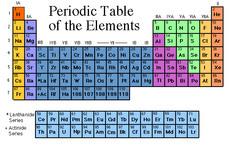
Periodic Table Unit Review
Quiz by Alison
Feel free to use or edit a copy
includes Teacher and Student dashboards
Measure skillsfrom any curriculum
Measure skills
from any curriculum
Tag the questions with any skills you have. Your dashboard will track each student's mastery of each skill.
With a free account, teachers can
- edit the questions
- save a copy for later
- start a class game
- automatically assign follow-up activities based on students’ scores
- assign as homework
- share a link with colleagues
- print as a bubble sheet
40 questions
Show answers
- Q1A table in which the chemical elements are arranged in order of increasing atomic #. Elements with similar properties are arranged in the same column (group), and elements with the same number of energy levels arranged in the same row (period).Periodic table30s
- Q2*A column on the periodic tableGroup30s
- Q3*A row on the periodic tablePeriod30s
- Q4Large group of elements that tend to be solids at room temp, good conductors of heat and electricity, malleable, ductile, and lustrousMetals30s
- Q5Group of elements that may be solids, liquids, or gases at room temp and tend to be poor conductors of heat and electricity, and NOT malleable, ductile, or lustrousNonmetals30s
- Q6Group of elements that have properties of metals or nonmetals, or somewhere inbetween. AKA "metalloids."Semimetals30s
- Q7Highly reactive family of elements that tend to be very soft, shiny metallic solids with low densities and melting points; have 1 valence e-.Alkali Metals30s
- Q8Less reactive family of metallic solids with higher densities and melting points than alkali metals; have 2 valence e-.Alkaline Earth Metals30s
- Q9Highly reactive family of nonmetals; all are diatomic; have 7 valence e-Halogens30s
- Q10Completely nonreactive family of nonmetals; have 8 valence e-; all are gases at room tempNoble Gases30s
- Q11Large block of metals in the center of the periodic table.Transition Metals30s
- Q12Consists of the lanthanides and actinides; two rows of elements set below the main body of the periodic tableInner Transition Metals30s
- Q13Exist in nature as single atoms - uncombined with other elements (e.g., Ag, Pt, Au, He, Ne)Monoatomic30s
- Q14Exist in nature in pairs - two of the same atom bonded together (e.g., H2, N2, F2...)Diatomic30s
- Q15Developed the first widely accepted periodic table in 1869Dmitri Mendeleev30s
